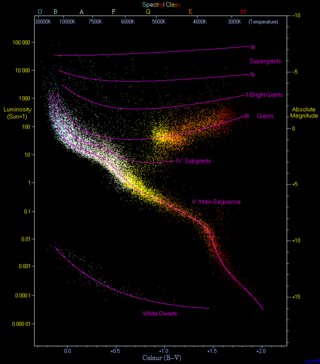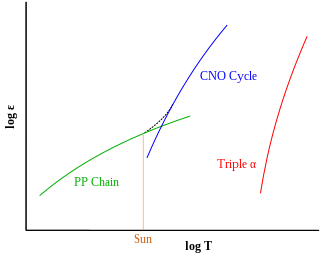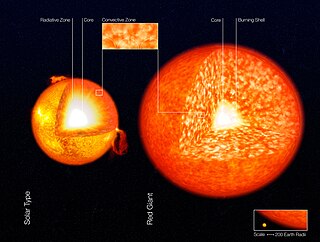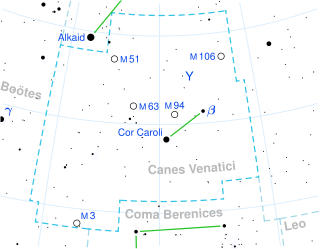Related Research Articles

In astronomy, the main sequence is a classification of stars which appear on plots of stellar color versus brightness as a continuous and distinctive band. Stars on this band are known as main-sequence stars or dwarf stars, and positions of stars on and off the band are believed to indicate their physical properties, as well as their progress through several types of star life-cycles. These are the most numerous true stars in the universe and include the Sun. Color-magnitude plots are known as Hertzsprung–Russell diagrams after Ejnar Hertzsprung and Henry Norris Russell.

A star is a luminous spheroid of plasma held together by self-gravity. The nearest star to Earth is the Sun. Many other stars are visible to the naked eye at night; their immense distances from Earth make them appear as fixed points of light. The most prominent stars have been categorised into constellations and asterisms, and many of the brightest stars have proper names. Astronomers have assembled star catalogues that identify the known stars and provide standardized stellar designations. The observable universe contains an estimated 1022 to 1024 stars. Only about 4,000 of these stars are visible to the naked eye—all within the Milky Way galaxy.

Stellar evolution is the process by which a star changes over the course of its lifetime and how it can lead to the creation of a new star. Depending on the mass of the star, its lifetime can range from a few million years for the most massive to trillions of years for the least massive, which is considerably longer than the current age of the universe. The table shows the lifetimes of stars as a function of their masses. All stars are formed from collapsing clouds of gas and dust, often called nebulae or molecular clouds. Over the course of millions of years, these protostars settle down into a state of equilibrium, becoming what is known as a main-sequence star.

The triple-alpha process is a set of nuclear fusion reactions by which three helium-4 nuclei are transformed into carbon.

In astrophysics, stellar nucleosynthesis is the creation of chemical elements by nuclear fusion reactions within stars. Stellar nucleosynthesis has occurred since the original creation of hydrogen, helium and lithium during the Big Bang. As a predictive theory, it yields accurate estimates of the observed abundances of the elements. It explains why the observed abundances of elements change over time and why some elements and their isotopes are much more abundant than others. The theory was initially proposed by Fred Hoyle in 1946, who later refined it in 1954. Further advances were made, especially to nucleosynthesis by neutron capture of the elements heavier than iron, by Margaret and Geoffrey Burbidge, William Alfred Fowler and Fred Hoyle in their famous 1957 B2FH paper, which became one of the most heavily cited papers in astrophysics history.

Supergiants are among the most massive and most luminous stars. Supergiant stars occupy the top region of the Hertzsprung–Russell diagram with absolute visual magnitudes between about −3 and −8. The temperature range of supergiant stars spans from about 3,400 K to over 20,000 K.

Red supergiants (RSGs) are stars with a supergiant luminosity class and a stellar classification K or M. They are the largest stars in the universe in terms of volume, although they are not the most massive or luminous. Betelgeuse and Antares A are the brightest and best known red supergiants (RSGs), indeed the only first magnitude red supergiant stars.

Mira variables are a class of pulsating stars characterized by very red colours, pulsation periods longer than 100 days, and amplitudes greater than one magnitude in infrared and 2.5 magnitude at visual wavelengths. They are red giants in the very late stages of stellar evolution, on the asymptotic giant branch (AGB), that will expel their outer envelopes as planetary nebulae and become white dwarfs within a few million years.
The carbon-burning process or carbon fusion is a set of nuclear fusion reactions that take place in the cores of massive stars (at least 8 at birth) that combines carbon into other elements. It requires high temperatures (> 5×108 K or 50 keV) and densities (> 3×109 kg/m3).

A helium flash is a very brief thermal runaway nuclear fusion of large quantities of helium into carbon through the triple-alpha process in the core of low-mass stars during their red giant phase. The Sun is predicted to experience a flash 1.2 billion years after it leaves the main sequence. A much rarer runaway helium fusion process can also occur on the surface of accreting white dwarf stars.

A giant star has a substantially larger radius and luminosity than a main-sequence star of the same surface temperature. They lie above the main sequence on the Hertzsprung–Russell diagram and correspond to luminosity classes II and III. The terms giant and dwarf were coined for stars of quite different luminosity despite similar temperature or spectral type by Ejnar Hertzsprung in 1905 or 1906.

A carbon star is typically an asymptotic giant branch star, a luminous red giant, whose atmosphere contains more carbon than oxygen. The two elements combine in the upper layers of the star, forming carbon monoxide, which consumes most of the oxygen in the atmosphere, leaving carbon atoms free to form other carbon compounds, giving the star a "sooty" atmosphere and a strikingly ruby red appearance. There are also some dwarf and supergiant carbon stars, with the more common giant stars sometimes being called classical carbon stars to distinguish them.

The asymptotic giant branch (AGB) is a region of the Hertzsprung–Russell diagram populated by evolved cool luminous stars. This is a period of stellar evolution undertaken by all low- to intermediate-mass stars (about 0.5 to 8 solar masses) late in their lives.

A convection zone, convective zone or convective region of a star is a layer which is unstable due to convection. Energy is primarily or partially transported by convection in such a region. In a radiation zone, energy is transported by radiation and conduction.

A subgiant is a star that is brighter than a normal main-sequence star of the same spectral class, but not as bright as giant stars. The term subgiant is applied both to a particular spectral luminosity class and to a stage in the evolution of a star.

La Superba is a strikingly red giant star in the constellation Canes Venatici. It is a carbon star and semiregular variable.
A technetium star, or more properly a Tc-rich star, is a star whose stellar spectrum contains absorption lines of the light radioactive metal technetium. The most stable isotope of technetium is 97Tc with a half-life of 4.21 million years, which is too short a time to allow the metal to be material from before the star's formation. Therefore, the detection in 1952 of technetium in stellar spectra provided unambiguous proof of nucleosynthesis in stars, one of the more extreme cases being R Geminorum.

An S-type star is a cool giant with approximately equal quantities of carbon and oxygen in its atmosphere. The class was originally defined in 1922 by Paul Merrill for stars with unusual absorption lines and molecular bands now known to be due to s-process elements. The bands of zirconium monoxide (ZrO) are a defining feature of the S stars.

A red giant is a luminous giant star of low or intermediate mass in a late phase of stellar evolution. The outer atmosphere is inflated and tenuous, making the radius large and the surface temperature around 5,000 K [K] or lower. The appearance of the red giant is from yellow-white to reddish-orange, including the spectral types K and M, sometimes G, but also class S stars and most carbon stars.
A stellar core is the extremely hot, dense region at the center of a star. For an ordinary main sequence star, the core region is the volume where the temperature and pressure conditions allow for energy production through thermonuclear fusion of hydrogen into helium. This energy in turn counterbalances the mass of the star pressing inward; a process that self-maintains the conditions in thermal and hydrostatic equilibrium. The minimum temperature required for stellar hydrogen fusion exceeds 107 K (10 MK), while the density at the core of the Sun is over 100 g/cm3. The core is surrounded by the stellar envelope, which transports energy from the core to the stellar atmosphere where it is radiated away into space.
References
- ↑ Sayeed, Maryum; et al. (March 2024). "Many Roads Lead to Lithium: Formation Pathways For Lithium-rich Red Giants". The Astrophysical Journal. 964 (1). id. 42. arXiv: 2306.03323 . Bibcode:2024ApJ...964...42S. doi: 10.3847/1538-4357/ad1936 .
- ↑ Lambert, D.L. (1992). "Observational effects of nucleosynthesis in evolved stars". In Edmunds, Mike G.; Terlevich, Roberto J. (eds.). Elements and the Cosmos. University of Cambridge. pp. 92–109. ISBN 0-521-41475-X.
- 1 2 Kwok, Sun (2000). The origin and evolution of planetary nebulae. Cambridge University Press. p. 199. ISBN 0-521-62313-8.